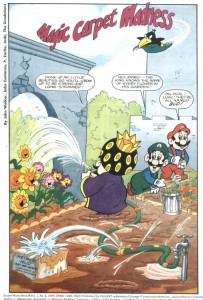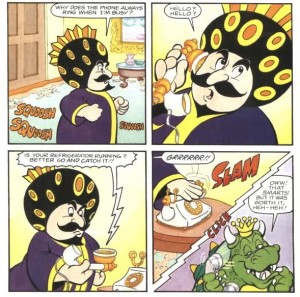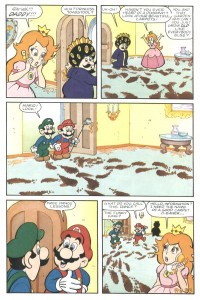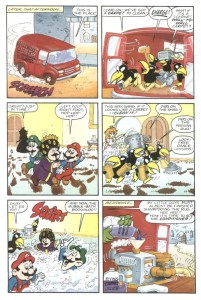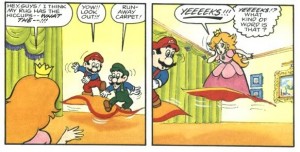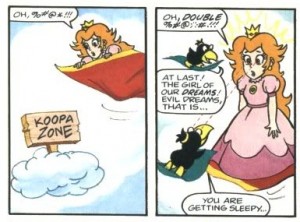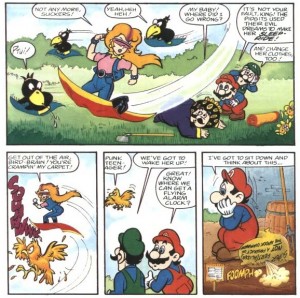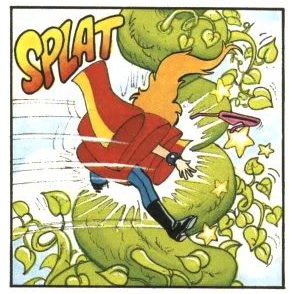Archive for category Video Games
Moving Away from Momentum
Posted by kjohnson1585 in Animation, Television, Uncategorized, Video Games on June 7, 2012
What happened to the promises of motion gaming?
I once was over at a friend’s house and watched him play Red Steel 2. Switching between swinging his sword and shooting his gun, after about an hour or so, he began to breath slightly heavier and sweat a little, the exaggerated movements for attacking making him grow weary. Understandable, as the Wii’s emphasis on motion is geared towards physical activity, as evidenced by WiiFit and WiiSports. And yet, after playing Legends of Zelda: Twilight Princess and Okami for hours at a time, I haven’t even begun to experience any type of exertion. Our setups are similar – we’re both seated 6-10 feet from the screen. I wondered then if he purposely developed more aggressive movements because he wanted to (subconsciously) exercise, while I’m content with low-key, flick-of-the-wrist movements, both of which are registered by the motion sensor exactly the same. In other words, I treat my Wiimote like a controller with an extra “motion button,” while my friend sees it as the physical manifestation of striking as Miyamoto probably hoped.
Either way, it’s difficult to think that motion gaming is actually moving in an interesting or innovating direction. We all considered motion gaming a gimmick when the Wii was first announced – but what we have now is worse, or more accurately, disappointing. The burden of proof was on Nintendo (and then with Microsoft’s Kinect and Sony’s Move) to show us something; if the recent E3 was anything, it showed that everyone dropped the ball.
Police 911 was the best thing that motion gaming came up with – a lavishly expensive arcade game pretty much only available at Dave and Busters. Motion gaming seemed to be a way to interact with the environment in ways that kept us up and on our toes in the heat of the moment; but it ended up being used for mini-games, light exercise, and quiet moments of stationary, semi-pinpoint aiming. We’ll never get that sword fighting/lightsaber game we dreamed of, and driving games without the tension of a real wheel is endearingly hopeless. Motion controls are inherently limiting, more so than I think any of us, even the programmers, really expected it to be. Gaming is about timing, accuracy, and precision, all things that motion controls inherently lack. The games themselves are designed to compensate for that (larger reticules, wider hit detection), and isn’t that exactly what motion controls were trying to avoid?
The larger problem was inferred from E3 and the wildly divergent (yet more of the same) games and features announced. Microsoft went heavy and hard with simultaneous multimedia venues, Sony essentially copied Nintendo’s ideas from seven years ago, and Nintendo rapped our knuckles like a college professor, teaching us how to play video games and giving us homework assignments on their website. The biggest draws were South Park’s The Stick of Truth (which had nothing to do with motion) and Ubisoft’s ZombiU, an intriguingly potential use of the new WiiU controller which still left me somewhat skeptical (and, hey, look, we’re back to zombies again). But what about those motion controls? The great pioneers of the technology even seemed to brush them off, like they ain’t no thing.
Motion controls can be simple (bowling a Wii ball) or complex (the bizarre way to help someone fish in Okami), but there’s no draw between the two, which prevents casual gamers becoming core gamers. Nothing is wrong with either group, but it’s no surprise that the WiiU so dropped early, since the casual market had no interest in exploring games beyond those simple, crowd pleasing ones; they simply are not going to go from Just Dance to No More Heroes; the furthest they’ll get is Mario Party (insert number here). So Nintendo decided to move on to the next “era” of consoles for casuals can easily play instead of pushing the capability of motion with the current gen. This not only leaves core gamers with more of the same, but does nothing to advance motion gaming as a real, potential method of entertainment. Somewhere, Milo is crying himself to digital sleep.
So, where are we at in the realm over motion gaming? If the WiiU is any indication, we’re looking a 360-degree digital landscape, a world that seems extremely vast to look at, but empty on the outskirts with no fertile soil to grow. Oh, well. There’s always zombies.
Digitial vs. Disks
Posted by kjohnson1585 in Film, Television, Uncategorized, Video Games, Writing on March 8, 2012
Tasha Robinson over at the AVClub writes about defending DVDs and their proliferating existence despite a general corporate ideology hellbent on getting rid of them, in favor of streaming and online downloads – in particular, Netflix CEO Reed Hastings’ ill-advised price move and failed secondary company geared to take care of the DVD-by-mail division. She links to a CNET article, here, which suggests that Netflix was attempting a bold move to strike early in destroying the physical media market, in essence forcing the switch by consumers.
What struck me about the CNET write-up was the rather disingenuous analogous claim that Apple killed floppies. I understand the metaphor – Apple struck early at a dying format before it was considered dying – but I don’t think he, CNET, and the proponents of such an idea understand history – or real history outside the manner in which we think about it. Malcolm Gladwell implied it strongly here, but history is not about crazy icons making ballsy decisions, but shrewd observers understanding general changing trends that naturally occur in progressive history. These observers/innovators understand social history, the broader sense of people’s changing tastes and ideas, instead of following titans and big names. In the case of Apple, Jobs was a keen insider (Gladwell also writes about his excitement over the first prototype of the mouse), always taking what was already circling the waters and making it accessible. While floppies were still around and used, so were flash drives, Zip Disks, CDs, early DVDs, and storage drives. He knew the floppy would die on its own with its limited capacity, and producing a computer without a floppy disc drive sparked outrage, sure, but not to the extent the CNET article implies, since Apple was such a small share of the market. It could afford the miss, save money, and bide its time.
Netflix mistakenly doesn’t have that freedom, at least not yet. John August agrees with Hastings about dropping DVDs; too bad no one else does, as shown by the Netflix fallout. The company does not have the under-the-radar corporate foothold like Apple did, and by forcing a change no one wanted or was ready for, was forced to pay the PR price. August, the CNET article, and even Robinson miss a fairly basic point; it has to do with the public’s accessibility over entertainment in general. It’s not that we want it now; we want whatever, whenever, now included. Let me put it like this:
I stream movies.
I also watch DVDs.
I also game, watch live TV, and go to movies, and read both books and ebooks. I do both, and roughly in equal measure, if one takes in consideration borrowing DVDs, Netflixing, Gamefying, and buying them. The switch may be inevitable, but the infrastructure is not in place, both in a physical one (streaming quality, bandwidth, caps on data usage, complicated ownership issues and online selection) and a consumer one (direct willingness to drop to streaming cold turkey). The former will be ready maybe in about 10 years, the latter in about… 25 years. I’m not being a Luddite here, I’m being realistic. And it’s not that people hate change, it’s people have to be ready for it, willing to pay for it, and able to troubleshoot it when that all fucks up for whatever reason.
John August in particular makes a dubious claim: “shiny discs are going to go away at some point, so why not now?” I suppose you could make the same argument for gas-powered cars, by the mere fact that fossil fuel is finite and the current course of action is globally unsustainable (which is ironic, considering he uses a climate change metaphor himself). But, again, the infrastructure is not in place physically (solar/electric stations across the country, selection, price) and consumer wise (willingness to switch, ability to manage repairs). Why not now? Because history, social history, deems it not ready. Hastings may be a “big man” as history is concerned, but all big men of history were only as functional as the time period warranted.
[Concerning piracy; iTunes already proved that music could combat it with a simple, intuitive setup, and the same thing with Steam; to imply there’s a straight-forward system in place that’s for film and TV is somewhat questionable, especially with Netflix losing streaming rights and the full extent of certain shows and movies spread across so many different formats. It’s purely inefficient and costly and limited. Too many choices and avenues exist to acquire content while media companies are struggling with copyrights, finances, and so on. Why should the consumer care? It’s their problem, and until they fix it, they’ll get there content the way they like without the BS.]
Are DVDs going to go away? Of course. But not fully until we have a distinct infrastructure in place to handle it, a simple, almost guaranteed method that when I click play on a streaming service, it plays in high quality video AND sound with no hiccups, that the selection is wide and varied and accessible anywhere in the house or on the road, and I can access the cool cover art and special features that the best DVDs have – and here’s the kicker – that all films, TV shows, and games can possess. A PS3 or XBox 360 owner likes the idea of gaming and watching movies on it and streaming with it; so does PC owners, and in time, TV owners. It’s hilarious that the hardware itself is distinctly ready for the transformation of accessibility but media companies and the software isn’t. It’s also fairly funny that film/TV viewers are complaining about this issue, but gamers aren’t (not as vigorously) since they have Steam, Origins, and ease to access discs. We at TMB really strive to think about entertainment outside the walls of strict media limits; if other people did the same, we could be solving this problem quicker than we have been so far.
Super Mario Comics – Magic Carpet Madness
Posted by kjohnson1585 in Animation, Comics, Super Mario Comics, Video Games, Writing on October 6, 2011
This next Super Mario Adventure comic, similar to “Just Desserts”, is riff with potential but falls short of narrative closure. It’s also a little goofier, more cartoony than the typical batch of comics in the anthology. Mario and Luigi are kinda tossed aside here as the comic relief, focusing on King Toadstool and Princess Toadstool. The next comic will play around with the brothers and their relationship; but this will give me a good opportunity to discuss the dynamics of the daughter/father relationship here.
King Toadstool isn’t that smart. He’s a loveable teddy bear, in which both words – “teddy” and “bear” – have tremendous weight. He doesn’t really think in terms of what’s best for Mushroom Kingdom, seemingly more content to sleep, eat, work in his garden, and otherwise sit around. (On occasion he will exercise a tremendous amount of rage, but it’s pretty rare, and usually comes from somewhere incompetent.) He loves his daughter, that much is for sure, but otherwise seem clueless when it comes to relationships, both private and public. It’s pretty clear the Mushroom Kingdom would be in shambles if it wasn’t for Toad, newcomer Wooster, and, most importantly, Princess Toadstool.
Every comic representation of Princess Toadstool has always been amazing; even the worse stories have managed to make the pink-dressed princess endearing in some way. She is also the most consistent. She balances herself between a classy, formal, slightly naggy feminine figure, and a badass, sarcastic, aggressive, fighter. The balance is less practical and more hilarious, but it also gets the job done. It’s pretty cool to see in this comic how she bounces back and forth between girly and grizzled.
We begin with a pretty solidly constructed establishing panel:
Note the Betty Boop-esque anthropomorphism with the flowers. Yeah, we’re in the cartoon realm here. It kinda reminds me of the judgmental bushes in “Piranha-Round Sue.” Seems the artists tend to use the anthropomorphic construct on background objects to reflect the overall tone of the panel in question. I can’t say it’s too effective – I mean, the dialogue and the coloring already reflects that – but it also a good visual cue to showcase that what you are reading is not, in any way, supposed to be seen as real or realistic. We’re off to a whimsical start.
The king walks inside the palace to answer a phone call – but is annoyed when it’s revealed to be a prank. But, by Bowser? More foreshadowing. I like how quick the tension starts – this is only the second page. What’s he up to?
While I love Princess Toadstool’s reaction to the muddy mess her father left (even the most machismo guys would flip a shit at that), seeing the Mario Bros. mistake the footprints as free dancing lessons is lame, even by 80s and 90s standards. Even if they’re being funny about it… I don’t know. It reeks of randomness, or more appropriately, a joke for joke sake, without putting too much thought behind giving the Mario Bros. any credibility. They’re kind of worthless throughout this comic. Also, Princess Toadstool’s direct comment to her father about “just growing old”? Surprisingly dark and somewhat cold. But, seriously, this is how she is. It’s crude, but so princess-y, and so amazing.
Princess, being practical, calls for a carpet cleaning service. Who arrives? Why, multiple pidgits (the black bird thing from the first page)! Also, they arrive in a van, which means the Mushroom Kingdom has cars. Nice to know they aren’t a completely nature-oriented species. (They also have airplanes and blimps, which appear later.)
So they clean the carpet, while Mario, Luigi, and the King continue to dance in the suds. It’s eye-rollingly annoying, and the jokes are the weakest elements here. There’s being silly, and being stupid, and when most of the cast just acts dumb, it drags everything down – which includes an insanely moronic future comic called “Duh, Stupid Bomb” later in the series. But I digress. As the carpet is conditioned, familiar Bowser-hands add in the secret ingredient Flying Carpet Juice, which looks like grape juice. As the namesake, the carpets begin to fly. In a pretty egregious error, the entire carpet doesn’t fly, but the various small rugs the characters HAPPEN TO BE STANDING ON fly. Also, why they just don’t jump off is unclear, especially the brothers, who are master jumpers. Just… guh, frustrating.
But we get some great Princess Toadstool moments. In the midst of carpet chaos, she has a profound thought:
She then starts bitching about stuff. Say what you will, but if this was happening in my house, I’d suddenly be mad about everything, too.
Which leads to my favorite moment – Princess Toadstool swearing. Twice:
Sure, it’s edited. But it’s there. She clearly drops to F-bombs as she reaches the (sigh) Koopa Zone (is this King Koopa’s airspace? How’d he negotiate that, right over the palace?!). Watching her Majesty just work through these panels is quite a delight. She’s commanding, snappy, random, and concerned all in the span of a few pages. And, with a bit of hypnosis…
She’s badass.
On closer inspection, this is a REALLY crazy moment. Notice the King immediately assuming his bad parenting. Take a gander at specifically what the Princess is wearing. Notice how she suddenly has complete control of the carpet. She even fucks with a random bird, who calls her a “punk teenager” (in case you didn’t get it). The funny part is that I could really see her being like this with not that much of a nudge. She’s incredibly snarky throughout the comic, who has more of a hipster personality more than anything, personified through some feminine wiles. It’ll be much clearer later on.
Nothing comes of any of this though. Mario sits on some plant food, which spills onto some beans, which grows into a giant beanstalk. They climb it in what seems to be like some attempt to grab her, but —
— she slams into the beanstalk instead because she was talking shit to a blimp. Kinda cute, but she’s falling, and about to DIE. Luckily, King Toadstool redeems his parenting skills:
And all is well. Mario and Luigi were useless all throughout, and Koopa got his, although in a whatever-kind of way. Still, King Toadstool’s lines in that panel are as sincere as they come. You cannot deny that father-daughter love, no matter how old Princess Toadstool wants him to get.
“Magic Carpet Madness” is pretty weak all over, but the nice moments with the Toadstool family dynamic have some solid underpinnings that will be worked on and refined in future issues. We’ll see more Princess Toadstool awesomeness in the next couple of issues as well, but next up is in-depth look at the Mario/Luigi relationship, one that will be a treat to explore and write about. That idea of Luigi being second to Mario’s heroics and character? Think again.



